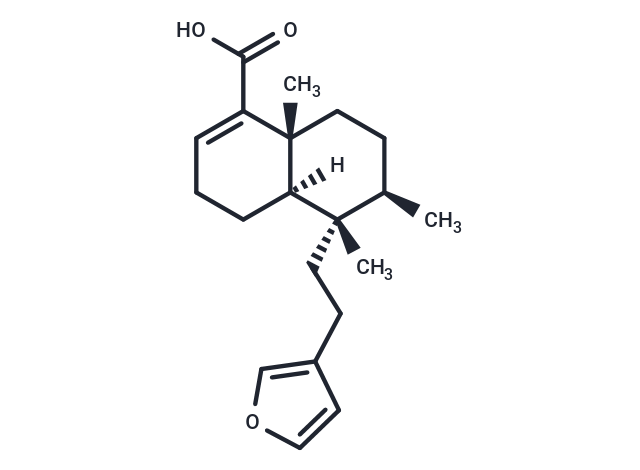Shopping Cart
- Remove All
 Your shopping cart is currently empty
Your shopping cart is currently empty

Hardwickiic acid ((-)-Hardwickiic acid) is a natural compound derived from Pulicaria gnaphalodes with anti-injury receptor properties. It blocks tetrodotoxin-sensitive voltage-dependent sodium channels and exhibits anti-inflammatory and insecticidal activity.

| Pack Size | Price | Availability | Quantity |
|---|---|---|---|
| 5 mg | $1,480 | Backorder | |
| 1 mL x 10 mM (in DMSO) | $1,968 | Backorder |
| Description | Hardwickiic acid ((-)-Hardwickiic acid) is a natural compound derived from Pulicaria gnaphalodes with anti-injury receptor properties. It blocks tetrodotoxin-sensitive voltage-dependent sodium channels and exhibits anti-inflammatory and insecticidal activity. |
| Targets&IC50 | J774:<100 µM |
| In vitro | Hardwickiic acid was isolated from the oleoresins of Copaifera spp. Hardwickiic acid did not show cytotoxicity in normal cell lines, nor did it show significant changes in viability of tumoral line cells. Hardwickiic acid (92.7% ± 4.9%) at 100 mM inhibited nitric oxide production in macrophages activated by lipopolysaccharide. In this assay, Hardwickiic acid did not inhibit tumor necrosis factor-α production.[1] |
| Alias | (-)-Hardwikiic acid |
| Molecular Weight | 316.43 |
| Formula | C20H28O3 |
| Cas No. | 1782-65-6 |
| Smiles | [H][C@]12CCC=C(C(O)=O)[C@]1(C)CC[C@@H](C)[C@]2(C)CCc1ccoc1 |
| Relative Density. | 1.068g/cm3 |
| Storage | store at low temperature,keep away from direct sunlight | Powder: -20°C for 3 years | In solvent: -80°C for 1 year | Shipping with blue ice. |

Copyright © 2015-2025 TargetMol Chemicals Inc. All Rights Reserved.